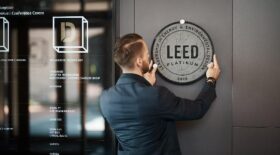When planning a new investment in the construction of a commercial building or the renovation of an existing one, various regulations and norms regarding energy efficiency are increasingly important. In a situation where energy prices and upkeep costs keep rising, compliance with energy efficiency principles will definitely pay off in the long run, but for maximum benefits, you should think about applying more than the minimum requirements and consider including respective specialists and consultants to apply for a LEED (Leadership in Energy and Environmental Design) certificate.

A LEED certificate provides an assurance from an independent third party (the United States Green Building Council) that the building is designed, constructed, and managed on a day-to-day basis in a way that is sustainable for people and the environment. This means that the building in question is in a sustainable location, its indoor climate meets quality standards, and water, energy, and other materials are used with efficiency principles in mind. Currently, there are about 100,000 contractors/managers in the world who own buildings with a LEED certificate or who are involved in this process, of which about 30 are in Estonia.
What will the process look like?
The first step in the certification process is a preliminary study, as a result of which, the optimum LEED level of the building is set for the project. You can choose between four different levels as your goal: Certified (40–49 points), Silver (50–59 points), Gold (60–79 points), and Platinum (80+ points). After the preliminary study, terms of reference are prepared for the parties to the project (architect, designers, owner’s supervision, construction team, owner) and instructions are given on how to implement LEED requirements. The necessary documents are then drawn up, evidence is gathered, and required data is collected. As part of the LEED certification process, an energy simulation meeting the LEED requirements and the ASHRAE (American Society of Heating, Refrigeration and Air-Conditioning Engineers) standard must also be prepared to compare the designed building to the reference building specified in the standard. This determines how far the designed building outperforms the reference building in terms of energy consumption and LEED points are awarded accordingly.
What is the role of the consultant throughout the project?
An energy efficiency consultant is a member of the team in a building design or renovation project and a committed supporter who assesses the LEED compliance of the solutions used and guides the rest of the team in meeting them. They prepare the terms of reference, provide guidance, and coordinate and prepare the documentation required for the certificate. The consultant is also the person who communicates with international parties involved in the application process, such as USGBC (the US Green Building Council) and GBCI (Green Business Certification Inc.). During the design phase, the consultant helps carry out an energy simulation to ensure that the systems operate according to the planned metrics. At the end of the certification process, i.e. after the completion of the building, the final document to be submitted to the consultant is the report of the integrated tests carried out by the builder and the owner’s supervision. This document is one of the prerequisites for LEED certification.
In Estonia, Forus offers consultations for applying for a LEED certificate; Forus is the first official member of the US Green Building Council (USGBC) in the Baltic countries. Members of our team have passed the necessary examinations and are holders of LEED Accredited Professional certificates. The fact that Forus also provides technical maintenance services is a huge advantage when it comes to LEED consultations because we can include specialists in heating, ventilation, cooling, and building automation systems in the process if necessary. Starting from 2014, Forus has partnered in the construction of several certified buildings in Estonia, and currently, we are involved in projects in all Baltic countries – in Estonia, the total volume is about 350,000 m2, in Latvia about 150,000 m2, and in Lithuania about 23,000 m2. In addition to buildings still under construction, we can offer advice on how to keep the certification of existing buildings.
Click here for more information on LEED certificates.


